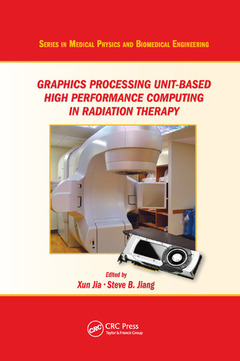Description
Graphics Processing Unit-Based High Performance Computing in Radiation Therapy
Series in Medical Physics and Biomedical Engineering Series
Coordinators: Jia Xun, Jiang Steve B.
Language: English
Subjects for Graphics Processing Unit-Based High Performance...:
Keywords
GPU Implementation; GPU computing; Dose Computation; GPU in Radiotherapy; MC; GPU in medical physics; CBCT; GPUs in clinical practice; VMAT; Medical Imaging; Dose Distribution; Monte Carlo radiation transport simulation; GPU Thread; computed tomography reconstruction; Ray Tracing; parallel processing platform for radiotherapy; FDK; CBCT Imaging; Imageguided Radiation Therapy; Dir; CBCT Image; MC Dose Calculation; CBCT Reconstruction; VMAT Plan; Cpu Cluster; GPU Card; Proton Therapy; Fourier Slice Theorem; CUDA Kernel; Single GPU; CBCT Scan; Dir Algorithm; Uence Map
Publication date: 09-2018
· 15.6x23.4 cm · Paperback
Publication date: 09-2015
· 15.6x23.4 cm · Hardback
Description
/li>Contents
/li>Biography
/li>
Use the GPU Successfully in Your Radiotherapy Practice
With its high processing power, cost-effectiveness, and easy deployment, access, and maintenance, the graphics processing unit (GPU) has increasingly been used to tackle problems in the medical physics field, ranging from computed tomography reconstruction to Monte Carlo radiation transport simulation. Graphics Processing Unit-Based High Performance Computing in Radiation Therapy collects state-of-the-art research on GPU computing and its applications to medical physics problems in radiation therapy.
Tackle Problems in Medical Imaging and Radiotherapy
The book first offers an introduction to the GPU technology and its current applications in radiotherapy. Most of the remaining chapters discuss a specific application of a GPU in a key radiotherapy problem. These chapters summarize advances and present technical details and insightful discussions on the use of GPU in addressing the problems. The book also examines two real systems developed with GPU as a core component to accomplish important clinical tasks in modern radiotherapy.
Translate Research Developments to Clinical Practice
Written by a team of international experts in radiation oncology, biomedical imaging, computing, and physics, this book gets clinical and research physicists, graduate students, and other scientists up to date on the latest in GPU computing for radiotherapy. It encourages you to bring this novel technology to routine clinical radiotherapy practice.
Introduction. Digitally Reconstructed Radiographs. Analytic Cone-Beam CT Reconstructions. Iterative Cone-Beam CT Reconstruction on GPUs: A Computational Perspective. 4DCT and 4D Cone-Beam CT Reconstruction Using Temporal Regularizations. Multi-GPU Cone-Beam CT Reconstruction. Tumor Tracking and Real-Time Volumetric Imaging via One Cone-Beam CT Projection. GPU Denoising for Computed Tomography. GPU-Based Unimodal Deformable Image Registration in Radiation Therapy. Inter-Modality Deformable Registration. CT-to-Cone-Beam CT Deformable Registration. Reconstruction in Positron Emission Tomography. Implementation of Convolution Superposition Methods on a GPU. Photon and Proton Pencil Beam Dose Calculation. Photon Monte Carlo Dose Calculation. Monte Carlo Dose Calculations for Proton Therapy. Treatment Plan Optimization for Intensity-Modulated Radiation Therapy (IMRT). Treatment Plan Optimization for Volumetric-Modulated Arc Therapy (VMAT). Non-Voxel-Based Broad Beam Framework: A Summary. Gamma Index Calculations. SCORE System for Online Adaptive Radiotherapy. TARGET: A GPU-Based Patient-Specific Quality Assurance System for Radiation Therapy.
Dr. Xun Jia is an assistant professor and medical physicist in the Department of Radiation Oncology at the University of Texas Southwestern Medical Center. Dr. Jia has published over 60 peer-reviewed research articles and is a section editor of the Journal of Applied Clinical Medical Physics. He has conducted productive research on developing numerical algorithms and implementations for low-dose cone-beam CT reconstruction and Monte Carlo radiation transport simulation on the GPU platform. He earned his MS in mathematics and PhD in physics from the University of California, Los Angeles.
Dr. Steve B. Jiang is the Barbara Crittenden Professor in cancer research, vice chair of the Radiation Oncology Department, and director of the Medical Physics and Engineering Division at the University of Texas Southwestern Medical Center. He is a fellow of the Institute of Physics and the American Association of Physicists in Medicine, serves on the editorial board of Physics in Medicine and Biology,and is an associate editor of Medical Physics. He has published more than 130 peer-reviewed papers on various areas of cancer radiotherapy. He received his PhD in medical physics from the Medical College of Ohio.
These books may interest you

External Beam Therapy 96.56 €



